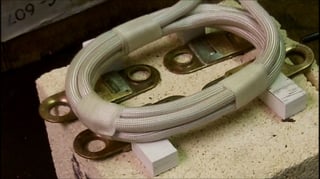Curing Material on an Aluminum Mandrel
Objective Heat a customer supplied aluminum cylinder to 80-120°C for a material curing application. More application notes
Processes
Processes: More
Processes: More

Industries:
Industries: More
Industries: More
Industries: More

Products:
Products: More
Services:
Services: More

Learn:
Learn: More
About:



A client had been soldering two copper strips at the same time but wanted to increase their throughput by soldering four concurrently. They turned to THE LAB at Ambrell to design a solution. The objective was to heat the four copper strips in ten seconds or less.
The engineers in THE LAB determined that an EASYHEATTM 5 kW induction soldering system with a single position four turn double wound helical coil would be optimal for the application. Four copper strips were placed under the coil approximately 0.25 inches (6.4 mm) away from it. The power was turned on and after seven seconds the larger parts began to separate indicating that the application achieved the target temperature of 400 ºF (204 ºC). A heating time of 10 seconds will ensure good flow. Placing the center of the coil turn over the center of the joint area offers the best performance for this application.
Benefits of this solution from THE LAB include rapid heating which increases throughput, precise heating, flameless heating, and an induction system that requires a minimal footprint. Click the image below to read more induction soldering application notes.

Objective Heat a customer supplied aluminum cylinder to 80-120°C for a material curing application. More application notes

In today’s manufacturing landscape, efficiency, precision, and sustainability are critical. Induction heating—a process that uses electromagnetic...

When it comes to many manufacturing processes, including this forging application, precision and efficiency are critical. Traditional heating methods...